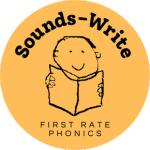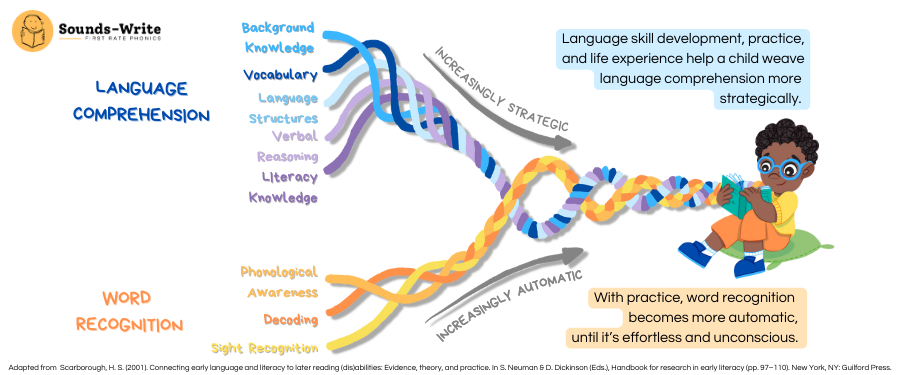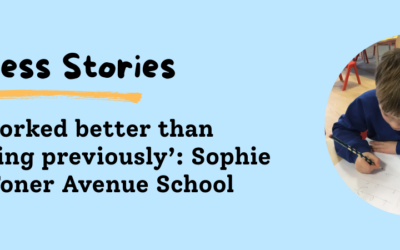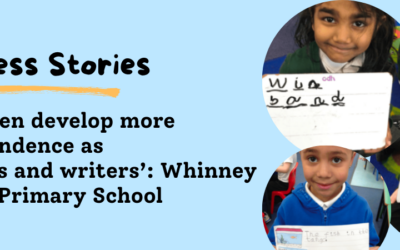Hey there, phonics enthusiasts! Today, we’re diving into the fascinating world of Scarborough’s Reading Rope. Don’t worry; it’s not a magic trick or an actual rope. Instead, it’s a metaphorical tool that helps us understand the intricacies of how we become fluent readers.
What is the Reading Rope?
There are few more effective metaphors for the development of skilled reading than the Reading Rope, devised by psychologist Hollis Scarborough in 2001. The metaphor depicts skilled reading as a rope woven with many strands. The strands originate either in language comprehension or word recognition, and these two primary strands slowly entwine. The rope metaphor helps educators and researchers visualise and comprehend the interconnected skills and knowledge required for proficient reading. ‘Skilled readers,’ says Scarborough in her 2001 paper on the topic, ‘are able to derive meaning from printed text accurately and efficiently. Research has shown that in doing so, they fluidly coordinate many component skills, each of which has been sharpened through instruction and experience over many years.’
Why was the metaphor created?
Dr. Scarborough developed the Reading Rope in response to the need for a more comprehensive model of reading that went beyond the traditional emphasis on phonics instruction. While phonics is an essential component of reading, it alone does not capture the full range of skills needed for successful reading comprehension and skilled reading.
The Reading Rope addresses the two key strands of reading: word recognition and language comprehension. The word recognition strand encompasses skills such as phonological awareness, decoding and sight recognition. It focuses on how readers identify and decode words accurately and efficiently. With practice, word recognition becomes more automatic, until it’s effortless and unconscious.
On the other hand, the language comprehension strand involves understanding the meaning of the words and integrating that understanding with background knowledge, vocabulary, and language skills. Language comprehension encompasses various aspects, including vocabulary development, syntactic awareness, background knowledge, and the ability to make inferences and connections. Language skill development, practice, and life experience help a child weave language comprehension more strategically.
Our take on the Reading Rope model
At Sounds-Write, we have one caveat when discussing the Reading Rope. The ‘sight recognition’ element of the lower strand is a little ambiguous and may encourage educators to include ‘sight words’ in their teaching methods. We do not encourage this practice, which you can read more about here. Instead, we think of that element of the Reading Rope as referring to the process of decoding words so fluently that it becomes automatic.
The metaphor emphasises the importance of both word recognition and language comprehension in skilled reading. To further the metaphor, when any one strand is weak or not tightly twisted enough, the strength of the entire rope is affected. It promotes a holistic approach to teaching reading, recognising that readers need a combination of skills and strategies to become proficient. The model encourages educators to provide explicit instruction in phonics, vocabulary, fluency and comprehension. Overall, Scarborough’s Reading Rope was developed to offer a comprehensive and nuanced perspective on reading, empowering educators to support students in becoming skilled and confident readers who can unlock the joys and benefits of literacy.
We’ve developed a free poster that you’re welcome to download and put up in your staff room to refer to.
Sounds-Write Webinars
Learn more about the Sounds-Write approach, our literacy training and decodable books by signing up to a free webinar.
You may also like
‘It´s worked better than anything previously’: Sophie Cox, Toner Avenue School
Toner Avenue School has achieved Silver School accreditation for their commitment to delivering high-quality phonics. Sophie Cox, Phonics Lead, tells us why they chose SoundsWrite and why it works so well for them.Why did you choose Sounds-Write and how did you find...
‘Children develop more independence as readers and writers’: Ruth Verrill, Whinney Banks Primary School
In 2019, Whinney Banks chose Sounds-Write as its phonics programme. Ruth Verrill, Early Reading and Phonics Lead, tells us how this led to a transformative journey for the school.Many of our pupils start school with low levels of speech and language, so an approach...
Building Reading Fluency: Practical Strategies for Educators
Fluency is often described as the bridge between learning to decode and reading with true comprehension. But what does fluency really involve and how can teachers best support it in the classroom? In our recent Sounds-Write webinar, Reaching Fluency, Practical...




